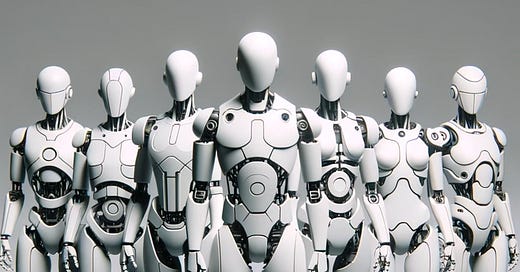Ten Companies Leading the Upcoming Humanoid Robot Wave
Commercial humanoid robots are coming and here are 10 companies working on bringing them to work alongside humans
For a long time, humanoid robots existed only in the world of science fiction. But thanks to advances in robotics and artificial intelligence, humanoid robots can not only walk but also dance and do parkour, and will soon work alongside humans. Some of them might even arrive next year.
How far are we from humanoid robots working alongside humans?
Many companies promise to have their robots available around 2024-2025. A more realistic estimate for humanoid robots to arrive would the second half of 2020s. No doubt every one of them will be a marvel of modern engineering and robotics technology. But they will need to prove they are worth the investment.
The environments we work and live in are designed, well, for us, humans. We live in complex environments full of objects designed to be manipulated with our hands and navigated on foot.
Introducing a robot into such an environment can be challenging. If you want to introduce an industrial robotic arm to your workflow that is currently optimized for human workers, there is a big chance you will need to redesign the workflow around the new robot. In some environments, like factories or warehouses, redesigning the workflow around robots makes sense. However, there are some environments, like hospitals, offices or our homes, where this kind of redesign is not feasible.
That would not be the case with a sufficiently capable humanoid robot. Such a robot can be dropped into any environment designed for humans and start operating in it without any changes in the environment or in the workflow. And unlike industrial robots, humanoid robots are being designed to share space with human workers and work together with them.
That sounds straightforward but it is not an easy task.
Humanoid robots need to be dexterous enough to operate in human environments. They need to be able to open doors, climb stairs, pick up objects, and use tools designed for human hands. They need to have good power sources and be energy-efficient to work for at least 4 hours on one charge. They need to be quiet to not drive human co-workers mad and smart enough to work effectively with them. These robots also need to be designed to be safe around humans. They need to be aware of their surroundings at all times and be able to predict what a human co-worker will do and what humans expect them to do. Add all those and many more challenges, and you get probably the most complex robots ever built.
One might ask then, why even bother with humanoid robots? Would it be easier to just hire a human?
The economic trends and the ageing population in developed countries, coupled with ongoing labour shortages, suggest that there might be fewer and fewer people willing or even able to work in the future. This will accelerate the development and deployment of robots. The robotics industry is already projected to grow significantly. According to BCG, the global robotics market is expected to reach between $160 billion and $260 billion by 2030, up from about $25 billion in 2021. There is a growing demand for more automation, and humanoid robots might find a niche for themselves. As mentioned earlier, these robots have the unique advantage of being able to be deployed into any human environment without making any changes to that environment. They can pick up tools designed for human hands and start using them straight away. From an employer's point of view, a sufficiently capable humanoid robot would not be that different from a human worker. If done correctly, this could open a massive market for humanoid robots automating previously hard-to-automate processes.
No one knows how humanoid robots will perform in an actual messy human environment working with actual human workers. To my knowledge, no one has deployed a sizable fleet of such robots and tested if they work as expected and how humans react to them. How well will humans and humanoid robots be able to communicate with each other? Will those robots be accepted by humans? Or will they be a source of tension, unpredictability or anxiety?
Additionally, there are economic considerations. Elon Musk estimates that the price of Tesla Optimus will eventually be around $20,000, while Apptronik projects that their robot could cost approximately $50,000 with scaled production. Whether investing in a fleet of humanoid robots is economically sensible remains to be seen. It might be more cost-effective to invest in robotic arms and adjust the workflow accordingly. It is also uncertain how many robotics companies will achieve enough sales to offset the research and development costs incurred while creating their robots.
Humanoid robots are here. The next step for them is to get out of research labs and operate alongside humans in the real world. They will be undoubtedly one of the most sophisticated and intelligent machines ever built. But they will need to prove they are worth the investment and are safe to work with humans. We will see in the second half of 2020s if they pass this crucial test.
10 companies working on commercial humanoid robots
At the moment, most of the companies working on humanoid robots are either still in the research and development phase or at the very beginning of offering commercial robots. Nevertheless, there are companies that believe they can fulfil the dream of creating machines built in our image. Here are ten such companies.
Keep reading with a 7-day free trial
Subscribe to Humanity Redefined to keep reading this post and get 7 days of free access to the full post archives.




